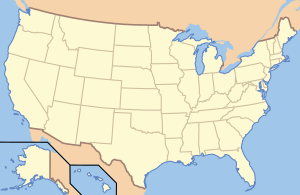Franklin Delano Roosevelt Memorial
|
Franklin Delano Roosevelt Memorial
|
|
| location | Washington, DC , USA |
| surface | 0.03 km² |
| Geographical location | 38 ° 53 ' N , 77 ° 3' W |
| Setup date | May 2, 1997 |
| administration | National Park Service |
The Franklin Delano Roosevelt Memorial is a memorial in Washington, DC to commemorate United States President Franklin Delano Roosevelt and his era. It is located in the southeastern part of the National Mall , on the banks of the Tidal Basin .
Franklin Delano Roosevelt Memorial

The memorial, inaugurated on May 2, 1997, has a total area of 30,000 m². Four different areas lead through 12 years of United States history , each area representing a term of office of Franklin Delano Roosevelt. Sculptures made from photographs show the 32nd President with his dog Fala and in his wheelchair. Other sculptures show scenes from the Great Depression , e.g. B. People listening to a Roosevelt radio address or men standing in line at a soup kitchen . A bronze statue of the First Lady Eleanor Roosevelt in front of the United Nations box commemorates her commitment to the UN .
Given Roosevelt's disability, the designers wanted to create a memorial that would be accessible to people with various physical disabilities. Among the special features is an area with tactile reliefs with lettering in Braille for the blind. Even so, the memorial was criticized by disability activists. Some of the reliefs and the inscriptions are said to have been placed so high that no blind person can feel them.
The statue of Franklin Roosevelt sparked discussions about his disability. The designers decided against the plan to show Roosevelt in a wheelchair. Instead, the president sits in a chair hidden by a cloak. He is shown as the public saw him during his lifetime. Roosevelt's dependence on a wheelchair was never made public during his lifetime, as it was considered a stigma of weakness and instability associated with a disability at the time. However, many wanted the handicap to be shown as they believed it was the source of its power. Other disability advocates, who were not necessarily against being portrayed in a wheelchair, had concerns that such a portrayal could make Roosevelt a hero because of his disability.
The sculptors added rollers to the back of the chair, but they can only be seen when standing behind the statue.
Many disability officials were still angry about the statue. A group led by the National Organization for People with Disabilities raised $ 1.65 million over two years to add a sculpture to the memorial showing the president in a wheelchair. In January 2001 the additional statue was placed near the entrance. It shows Roosevelt in a wheelchair very similar to the one he used.
Running water is an important physical and metaphorical component of the memorial. Each “room” contains a waterfall. As you go from one room to the next, the falls get bigger and more complex. This reflects the increasing complexity of the presidency, which was influenced by the great upheavals of the economic depression and the world war. When the memorial opened, visitors were asked to wade through the fountains and waterfalls. However, after a few days, the National Park Service banned visitors from entering the water because they could not find insurance.
Travel guides describe the symbolism of the 5 main water areas as follows:
- A single big drop - The collapse of the economy that led to the Great Depression
- Various Growing Drops - The Tennessee Valley Authority Dam Construction Projects
- Chaotic waterfalls with different angles - World War II
- A resting basin - Roosevelt's death
- A Wide Range of the Previous Falls - A Review of Roosevelt's Presidency.
Smaller waterfalls and a reflection pool, which are located between the “rooms”, give the theme of water continuity.
The memorial was designed by Lawrence Halprin and contains sculptures and work by Leonard Baskin, Neil Estern, Robert Graham , Thomas Hardy, and George Segal . The National Memorial is part of the National Mall and Memorial Parks . As a National Park Service- Managed Historic Area, the memorial has been listed on the National Register of Historic Places since it opened on May 2, 1997 .
Roosevelt's Thoughts on a Monument
Roosevelt had told his friend Felix Frankfurter that he only wanted a small, simple memorial. On the 20th anniversary of his death, the memorial was erected on a lawn on the corner of 9th Street and Pennsylvania Avenue.
gallery
Statue of the President and his dog Fala
Small artificial waterfalls in the memorial
Individual evidence
- ↑ http://www.raggededgemagazine.com/archive/fdr.htm
- ↑ according to the National Register of Historic Places of the National Park Service
Web links
- Official NPS website: Franklin Delano Roosevelt Memorial
- FDR Wheelchair Statue Campaign: NOD.org







